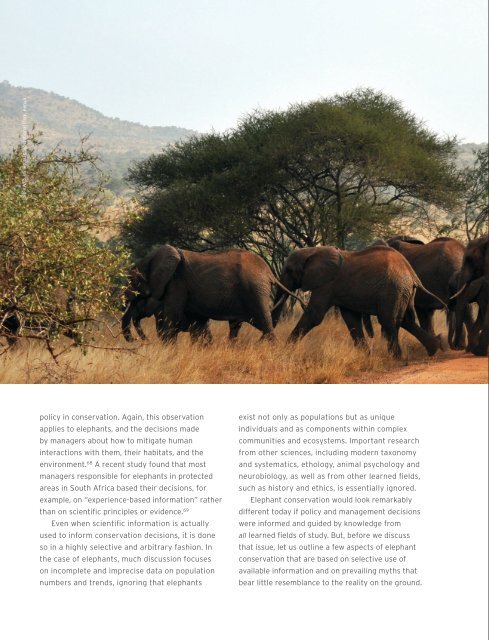ELEPHANTS & IVORY
ELEPHANTS & IVORY
ELEPHANTS & IVORY
You also want an ePaper? Increase the reach of your titles
YUMPU automatically turns print PDFs into web optimized ePapers that Google loves.
© IFAW/D. Willetts/Tsavo National Park, Kenya<br />
policy in conservation. Again, this observation<br />
applies to elephants, and the decisions made<br />
by managers about how to mitigate human<br />
interactions with them, their habitats, and the<br />
environment. 68 A recent study found that most<br />
managers responsible for elephants in protected<br />
areas in South Africa based their decisions, for<br />
example, on “experience-based information” rather<br />
than on scientific principles or evidence. 69<br />
Even when scientific information is actually<br />
used to inform conservation decisions, it is done<br />
so in a highly selective and arbitrary fashion. In<br />
the case of elephants, much discussion focuses<br />
on incomplete and imprecise data on population<br />
numbers and trends, ignoring that elephants<br />
exist not only as populations but as unique<br />
individuals and as components within complex<br />
communities and ecosystems. Important research<br />
from other sciences, including modern taxonomy<br />
and systematics, ethology, animal psychology and<br />
neurobiology, as well as from other learned fields,<br />
such as history and ethics, is essentially ignored.<br />
Elephant conservation would look remarkably<br />
different today if policy and management decisions<br />
were informed and guided by knowledge from<br />
all learned fields of study. But, before we discuss<br />
that issue, let us outline a few aspects of elephant<br />
conservation that are based on selective use of<br />
available information and on prevailing myths that<br />
bear little resemblance to the reality on the ground.<br />
THERE ARE “TOO MANY <strong>ELEPHANTS</strong>”<br />
In conservation today, we frequently hear that<br />
there are too many animals, whether they be<br />
cormorants, deer or wolves in North America,<br />
kangaroos in Australia, seals in Canada and<br />
Scotland, whales in the world’s oceans or, indeed,<br />
elephants. 70 This phenomenon, which ironically<br />
often involves threatened or endangered species 71<br />
is frequently discussed, even by people calling<br />
themselves scientists, as “overpopulation”,<br />
“overabundance”, even “hyperabundance”. 72<br />
From the outset, let’s be clear. The idea of<br />
overabundance is not a scientific concept. It is<br />
a value judgment. Science can never tell us how<br />
many animals there should be in one place at one<br />
time because no such number exists. We all know<br />
people for whom a single mouse in the kitchen<br />
pantry represents a local “overabundance” of<br />
mice. One mouse in the house is one mouse too<br />
many!<br />
When people, including scientists, talk about<br />
overabundance, they are actually referring to the<br />
maximum number of individuals of a species that<br />
they are willing to tolerate in one place at one<br />
time, what academics sometimes call “cultural<br />
carrying capacity”. Cultural carrying capacity<br />
depends entirely on human attitudes towards a<br />
species, not on biological principles.<br />
Where there are more elephants locally than<br />
49


